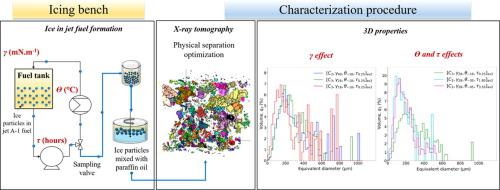Chemical Engineering Science ( IF 4.7 ) Pub Date : 2021-05-07 , DOI: 10.1016/j.ces.2021.116737 Iheb Haffar , Frédéric Flin , Christian Geindreau , Nicolas Petillon , Pierre-Colin Gervais , Vincent Edery

|
Icing in aircraft fuel systems remains a serious issue for aviation safety and security. It is linked to the geometrical properties of the ice particles formed in situ, which are themselves highly sensitive to the operating parameters of the fuel system. In this work, an experimental campaign was conducted with a fuel-icing bench to explore the impact of the interfacial tension (), the sampling temperature () as well as the recirculation time of the particles in the injection loop (). For this purpose, a new sampling method has been defined, tested and validated, using paraffin oil (PO) as an impregnation product for ice particles. The specimens were prepared, set up in a cryogenic cell and then scanned using X-ray Micro-Computed Tomography (μCT). Image processing and analyses allowed computation of the 3D properties at 5 m resolution. The impregnation with PO revealed satisfying results in terms of physical separation of ice particles (more than 66%), especially for the smallest ones (200 m), thus limiting the sintering phenomenon over time. The decrease in values showed a slight tendency to form smaller particle size distributions widths (). The observed influence of was minor due to its interference with , which proved to have the strongest effect on particle size and morphology. Thus, the increase in promoted the formation of smaller with modes 100 m. The elongation () and flatness () form factors showed significant tendencies (40%) towards rounded and spherical shapes for all ice specimens. The mean curvature distributions showed a trend towards convexities either by decreasing or increasing values. This study illustrates the complex impact of process parameters on the geometric properties of ice particles in jet fuel. The obtained results may be useful for further testing of filter clogging phenomena or numerical simulation and modeling studies.
中文翻译:

界面张力、温度和再循环时间对喷气A-1燃料中冰粒3D特性的影响
飞机燃油系统结冰仍然是航空安全和安保的一个严重问题。它与原位形成的冰粒的几何特性有关,这些冰粒本身对燃料系统的运行参数高度敏感。在这项工作中,使用燃料结冰台进行了一项实验活动,以探索界面张力的影响()、采样温度 () 以及颗粒在进样回路中的再循环时间 ()。为此,定义、测试和验证了一种新的采样方法,使用石蜡油 (PO) 作为冰粒的浸渍产品。制备样本,将其放置在低温细胞中,然后使用 X 射线微计算机断层扫描 (μCT) 进行扫描。图像处理和分析允许在 5 处计算 3D 属性米分辨率。PO 的浸渍在冰颗粒的物理分离(超过 66%)方面显示出令人满意的结果,尤其是对于最小的冰颗粒(200 m),从而限制烧结现象随时间的推移。的减少 值显示出形成较小粒度分布宽度的轻微趋势()。观察到的影响 由于干扰 ,这被证明对粒度和形态有最强的影响。因此,增加 促进了小规模的形成 带模式 100 米。伸长率() 和平整度 () 外形因素显示出显着的趋势 (40%) 使所有冰标本都变成圆形和球形。平均曲率分布呈凸度趋势 或增加 值。这项研究说明了工艺参数对喷气燃料中冰粒几何特性的复杂影响。获得的结果可用于进一步测试过滤器堵塞现象或数值模拟和建模研究。



























 京公网安备 11010802027423号
京公网安备 11010802027423号